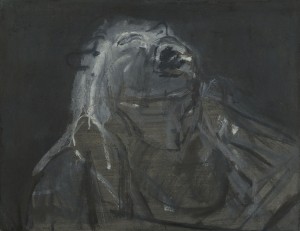Thus it is that art remained aloof from the establishment. Its language could not be used to compose texts in which everyday reality dared show itself. This is exactly why a syndrome of conservatism emerged in art: it was constantly striving to hold on to its sovereignty and the integrity of its language (or at least, to the indications that its language had value). But it was already impossible to preserve “the language of art”.
The language of art was torn apart into pieces and adapted to the dictionary of a new everyday conventionality. This is why the practice of art in the 1960s and 1970s took on the form of laboratory work.
Every piece of art produced by Alexander Maximov is an experiment, an investigation, a series of tests. At the same time, it is, in fact, an enlightenment. The artist laughs at himself upon noticing that he is becoming a painter, an abstractionist, a poster artist, ana..ve artist or a commentator on images. He shuns definition and avoids coming into being. To come into being means to stop, but his work requires the possibility of movement, indefinite changes in language, and the emergence of texts. He is not so self-assured as to play with art. Yet he notices that he is always getting involved in strange games; the art he is pursuing today is actually playing with him and abolishing the former rules of the game as well as the role of the artist himself.
The artist understands that there is no uniform, homogenous art space or single the language of art. But there are attempts at expression by producing images, each of which results in an imprint that is today considered art.
How does the artist know about this? Is it due to his ability to identify with today’s work and his cognizance of losing identity with yesterday’s? Is it because he accepts the fact that his name has already started its way down the labyrinths of transformation, has begun multiplying and disappearing, and is now running the risk of being totally lost, erased and forgotten among an endless number of incarnations? Or is it due to his desire to become someone or something else, to no longer play the role of the artist by practicing art, or to accept responsibility for that which becomes art, despite the fact that being an artist very often means being no-one at all?
The artist stands aside and watches as he disappears from every place he could be. Nevertheless, he insistently signs his name on every scrap of paper and notes the day and the hour when the event occurred. This is yet one more instantiation of his presence, one more piece of evidence pointing to the existence of a different art.
When contemporary culture uses the term “expressionism” to refer to stylistic features, its intention is very clearly to say that style is a contract, an indication that art has been defeated by the contractual obligations of culture. In reality, however, the meaning of expressionism in Russia goes far beyond the boundaries of style. Expressionism is the very poetics of art which always remains an outsider to the vast cultural space and which is always aware that its marginal status is, in fact, its personal art language.
This is why on a map of art, the location of expressionism is represented by a break in the unified model of modernity.
Expressionism tested the limits of art, and together with other styles determined where exactly its boundaries were. At the same time, it was the foundation on which 20th century art began to demarcate the limits of contemporary culture and a system that broke the barriers that separated art from everyday conventionality. The works produced by the efforts of expressionists passed on into everyday culture, and are still today being interpreted as violations of proper order and breaches in the continuous flow of modern life.
So it is that the 20th century read its texts anew; texts that insisted on taking no part in the communal project of contemporary culture; and immersed itself in the state of an alternate present. In doing so, it approached the differentiation of modernism and contemporariness.
1. Марцинский Г. Метод экспрессионизма в живописи. Петербург: Academia, 1923. С. 5
2. Пунин Н. Н. Квартира № 5 // Панорама искусств: Сб. М., 1989. № 12. С. 177
3. Ibid. С. 176
4. Ibid. С. 174
5. Ге Н. Н. Мир художника. Письма. Статьи. Критика. Воспоминания современников. М.: Искусство, 1978. С. 118
6. Синий всадник. М.: Изобразительное искусство, 1996. С. 21
7. Синий всадник. М.: Изобразительное искусство, 1996. С. 25
8. Ге Н. Н. Мир художника. Письма. Статьи. Критика. Воспоминания современников. С. 119
9. Маковец. Сборник материалов по истории объединения. М., 1994. С. 70–71
10. Булгаков М. А. Романы. Мастер и Маргарита. Л.: Художественная литература, 1978. С. 446
11. Витинг Н. И. На пороге вечности. Воспоминания. Рукопись. С. 16
12. Витинг Н. И. На пороге вечности. Воспоминания. Рукопись. С. 16–17
13. See: Соколов И. Хартия экспрессиониста. Экспрессионизм. Бедекер по экспрессионизму // Литературные манифесты от символизма до наших дней: Сб. М., 2000
14. Блок А. А. Памяти Врубеля. Сочинения: В 2 т. Т. 2. М.: ГИХЛ, 1955. С. 146
15. Блок А. А. О современном состоянии русского символизма. Сочинения: В 2 т. Т. 2. М.: ГИХЛ, 1955. С. 156
16. Редько К. Н. Парижский Дневник. М.: Советский художник, 1992. С. 64
17. Маковец. Сборник материалов по истории объединения. М., 1994. С. 71
18. Андрей Белый. М.: Советская Россия, 1989. С. 583
19. Ibid. С. 603
20. Ерофеев В. Москва – Петушки // Оставьте мою душу в покое. М.: Х.Г.С., 1995. С. 136
21. Булгаков М. А. Романы. Мастер и Маргарита. Л.: Художественная литература, 1978. С. 477
22. Ерофеев В. Москва – Петушки. С. 54–55




Капитановский Александр
25 Aug 2012
Встретил Ваши тексты, прежде не довелось. Теперь читаю. С благодарностью и уважением.